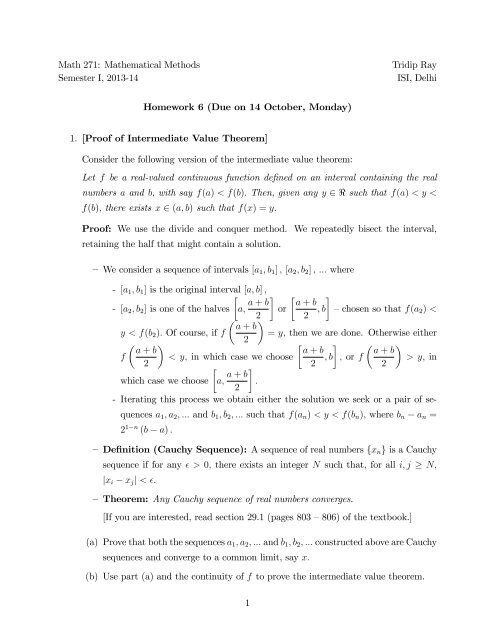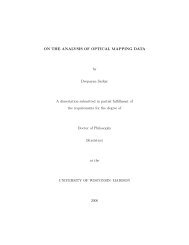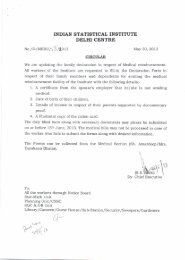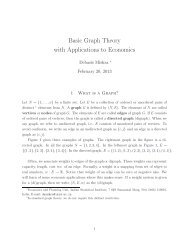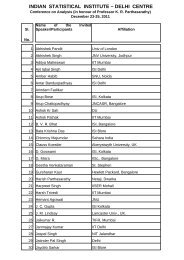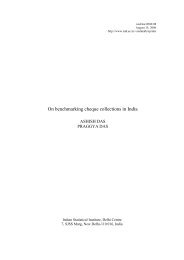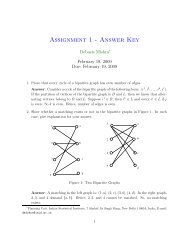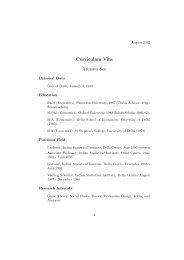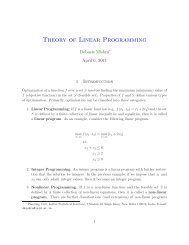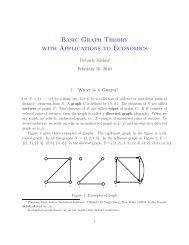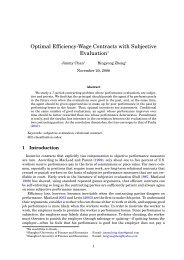Homework 6
Homework 6
Homework 6
You also want an ePaper? Increase the reach of your titles
YUMPU automatically turns print PDFs into web optimized ePapers that Google loves.
Math 271: Mathematical Methods<br />
Semester I, 2013-14<br />
Tridip Ray<br />
ISI, Delhi<br />
<strong>Homework</strong> 6 (Due on 14 October, Monday)<br />
1. [Proof of Intermediate Value Theorem]<br />
Consider the following version of the intermediate value theorem:<br />
Let f be a real-valued continuous function defined on an interval containing the real<br />
numbers a and b, with say f(a) < f(b). Then, given any y ∈ R such that f(a) < y <<br />
f(b), there exists x ∈ (a, b) such that f(x) = y.<br />
Proof: We use the divide and conquer method. We repeatedly bisect the interval,<br />
retaining the half that might contain a solution.<br />
— We consider a sequence of intervals [a 1 , b 1 ] , [a 2 , b 2 ] , ... where<br />
- [a 1 , b 1 ] is the original interval [a, b] ,<br />
[<br />
- [a 2 , b 2 ] is one of the halves a, a + b ] [ ] a + b<br />
or<br />
2 2 , b —chosen so that f(a 2 ) <<br />
( ) a + b<br />
y < f(b 2 ). Of course, if f = y, then we are done. Otherwise either<br />
( )<br />
2 [ ] ( )<br />
a + b<br />
a + b<br />
a + b<br />
f < y, in which case we choose<br />
2<br />
2 , b , or f > y, in<br />
[<br />
2<br />
which case we choose a, a + b ]<br />
.<br />
2<br />
- Iterating this process we obtain either the solution we seek or a pair of sequences<br />
a 1 , a 2 , ... and b 1 , b 2 , ... such that f(a n ) < y < f(b n ), where b n − a n =<br />
2 1−n (b − a) .<br />
— Definition (Cauchy Sequence): A sequence of real numbers {x n } is a Cauchy<br />
sequence if for any ɛ > 0, there exists an integer N such that, for all i, j ≥ N,<br />
|x i − x j | < ɛ.<br />
— Theorem: Any Cauchy sequence of real numbers converges.<br />
[If you are interested, read section 29.1 (pages 803 —806) of the textbook.]<br />
(a) Prove that both the sequences a 1 , a 2 , ... and b 1 , b 2 , ... constructed above are Cauchy<br />
sequences and converge to a common limit, say x.<br />
(b) Use part (a) and the continuity of f to prove the intermediate value theorem.<br />
1
2. [Alternative Proof of Intermediate Value Theorem]<br />
(a) Prove the following proposition:<br />
Let f be a real-valued function defined on an interval S in R. Assume that f is<br />
continuous at a point c in S and that f (c) ≠ 0. Then there is an open ball B δ (c)<br />
such that f(x) has the same sign as f(c) in B δ (c) ∩ S.<br />
(b) Prove the following theorem:<br />
Let f be a real-valued and continuous function on a compact interval [α, β] in R,<br />
and suppose that f(α) and f(β) have opposite signs. Then there is at least one<br />
point γ in the open interval (α, β) such that f(γ) = 0.<br />
- Hints: For definiteness, assume f(α) > 0 and f(β) < 0. Define the set<br />
A = {x: x ∈ [α, β] and f(x) ≥ 0} .<br />
Then A is nonempty since α ∈ A, and A is bounded above by β. Let γ =<br />
supremum of A. Then α < γ < β. Prove that f(γ) = 0. [Suppose not, and<br />
then use (a) to come up with a contradiction.]<br />
(c) Use (b) to prove the following version of the intermediate value theorem:<br />
Let f be a real-valued continuous function defined on an interval containing the<br />
real numbers a and b, with say f(a) < f(b). Then, given any y ∈ R such that<br />
f(a) < y < f(b), there exists x ∈ (a, b) such that f(x) = y.<br />
3. Let f : [a, b] → [a, b] be a continuous function on [a, b]. Prove that there exists some<br />
β ∈ [a, b] such that f (β) = β.<br />
4. Let S be a closed interval and let 0 < α < 1. Let f : S → S satisfies the inequality<br />
|f (x) − f (y)| ≤ α |x − y| , for each x ∈ S and y ∈ S.<br />
(a) Prove that f is continuous on S.<br />
(b) Let x 1 ∈ S and define a sequence of real numbers whose (n + 1)th element is<br />
x n+1 = f (x n ) , n = 1, 2, 3, ... Prove that this sequence is a Cauchy sequence.<br />
[Hint: |x n+1 − x n | = |f (x n ) − f (x n−1 )| ≤ α |x n − x n−1 | .]<br />
(c) Use (a) and (b) to prove that there exists x ∗ ∈ S such that f (x ∗ ) = x ∗ .<br />
2
5. Let f be a convex function on the interval I and x 1 , x 2 and x 3 be points of I which<br />
satisfy x 1 < x 2 < x 3 .<br />
Prove that<br />
f (x 2 ) − f (x 1 )<br />
x 2 − x 1<br />
≤ f (x 3) − f (x 1 )<br />
x 3 − x 1<br />
≤ f (x 3) − f (x 2 )<br />
x 3 − x 2<br />
.<br />
6. Prove the following proposition (Jensen’s Inequality):<br />
Suppose A is a convex set in R n and f : A → R is a concave function. Then, for any<br />
integer m > 1,<br />
( m<br />
)<br />
∑<br />
m∑<br />
f θ i x i ≥ θ i f ( x i)<br />
i=1<br />
i=1<br />
∑<br />
whenever x 1 , x 2 , ..., x m ∈ A, (θ 1 , θ 2 , ..., θ m ) ∈ R m + and m θ i = 1.<br />
7. Let f : R + → R + be a strictly concave function. Let a, b, c, d be arbitrary positive<br />
real numbers satisfying (i) a + d = b + c, and (ii) a < b < c < d. Show that<br />
f (a) + f (d) < f (b) + f (c) .<br />
i=1<br />
8. If a and b are arbitrary positive real numbers, show that<br />
a θ b 1−θ ≤ θa + (1 − θ) b, for every 0 < θ < 1.<br />
9. Let f : R + → R + be a continuous function on R + which is twice continuously differentiable<br />
on R ++ with f ′ (x) > 0 and f ′′ (x) < 0 for all x in R ++ . Show that for every<br />
x in R ++ , f (x) > f ′ (x) .<br />
x<br />
10. Let f : R 2 → R be a quasi-concave function. Let I be the closed interval [0, 1] . Let<br />
a, b be two arbitrary given vectors in R 2 . Define a function g : I → R by g (t) =<br />
f (ta + (1 − t) b) . Prove that g is a quasi-concave function on I.<br />
11. Suppose A is a convex set in R n and f : A → R. Prove that the following two statements<br />
are equivalent to each other:<br />
(a) f (x 2 ) ≥ f (x 1 ) implies f (θx 1 + (1 − θ) x 2 ) ≥ f (x 1 ) whenever x 1 , x 2 ∈ A, and<br />
0 ≤ θ ≤ 1;<br />
(b) For every α ∈ R, the set S (α) = {x ∈ A : f (x) ≥ α} is a convex set in R n .<br />
3


